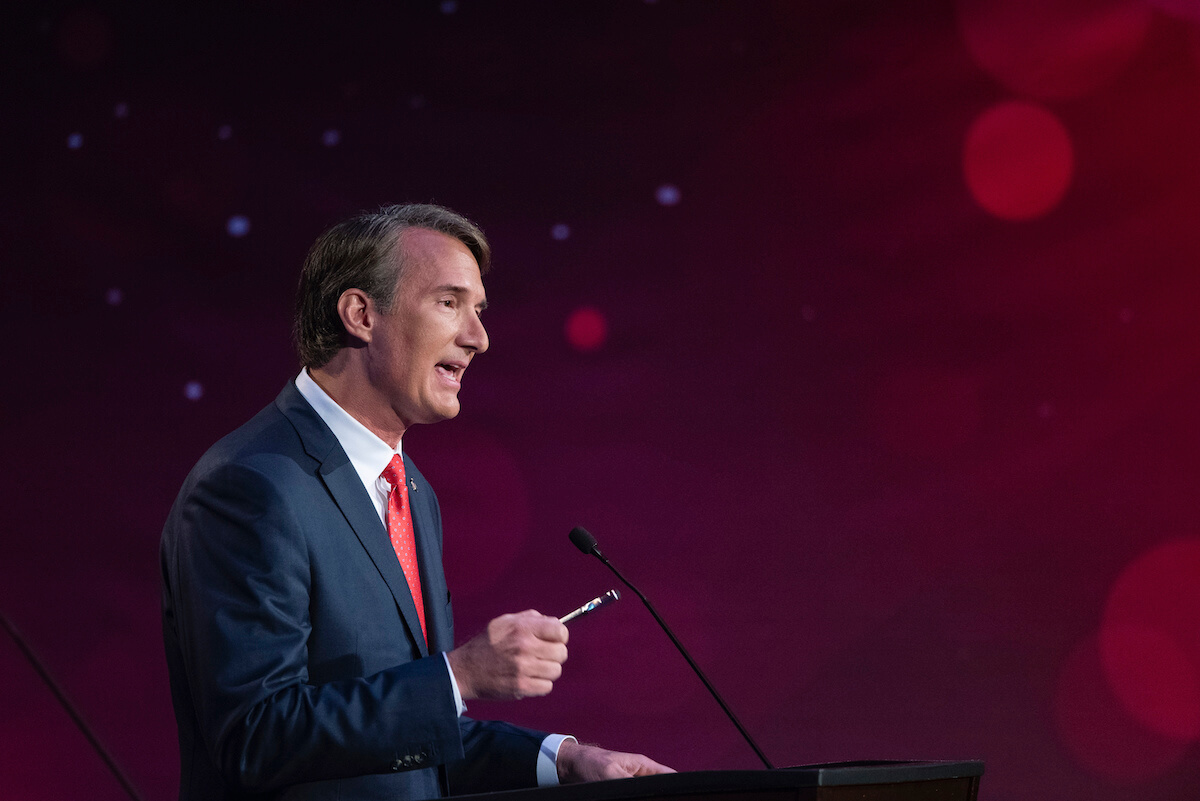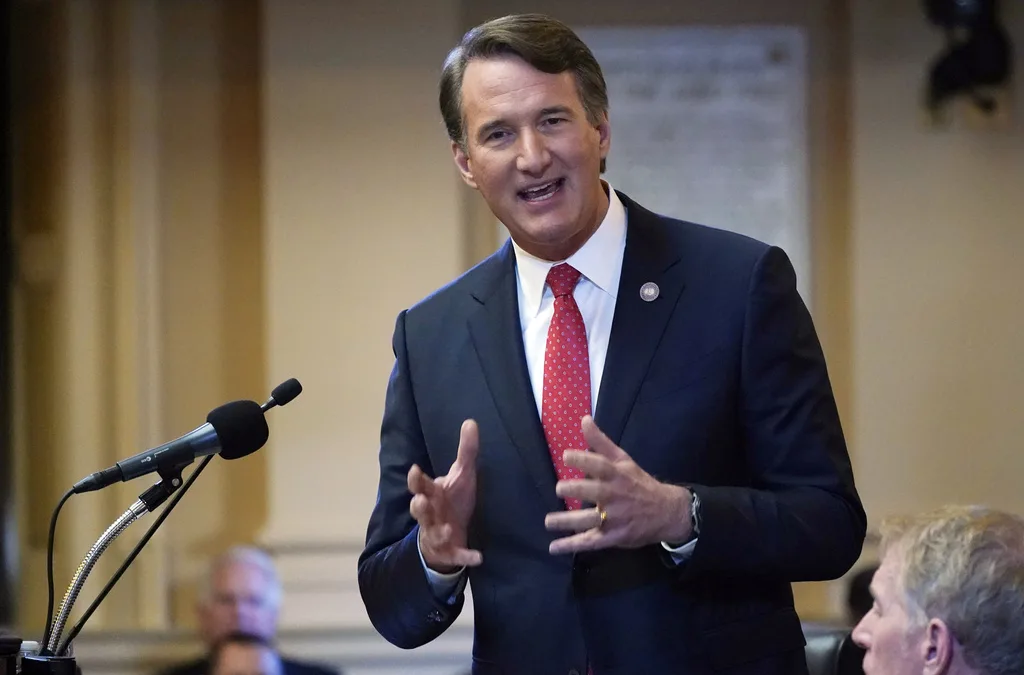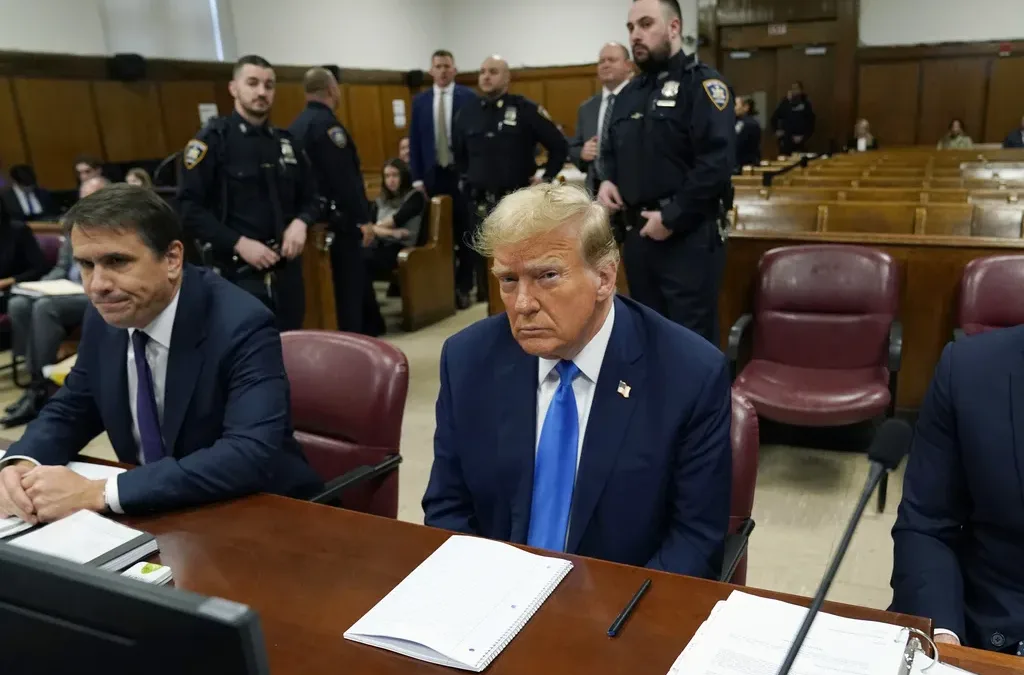
Virginia republican gubernatorial candidate Glenn Youngkin, participates in a debate with democratic gubernatorial candidate former Governor Terry McAuliffe at Northern Virginia Community College, in Alexandria, Va., Tuesday, Sept. 28, 2021. (AP Photo/Cliff Owen)
2020 saw an increase in murders in Virginia and 45 other states across the country. Politicians like Glenn Youngkin have one explanation for that increase, but we actually did the research. Here’s the truth.
You love your family. You—and all 8.6 million people living in Virginia—want to protect them from the scary world that cable news networks and social media platforms tell you we’re living in. Day after day, you receive this message. It’s so constant that you’d be forgiven for thinking much of the US has descended into violent lawlessness. Even though your little corner of the red, white, and blue seems to be okay, you’re scared the chaos is going to find its way to your front door.
So when a seemingly upstanding gentleman in a suit knocks on that very door, tells you to blame this other guy for the violence that is supposedly everywhere, and promises to protect your family—it makes sense that you might believe him.
This, in a nutshell, is what’s happening right now in Virginia and all across America.
Fifty-nine percent of Americans believe crime is an “extremely serious or very serious issue in America,” according to a June 2021 Washington Post poll. But the same poll found that only 17% said this was true for where they live. Another poll, this one conducted by Yahoo in July, found that 70% of Americans believe crime is up in America, but only 37% said crime is up where they live.
Clearly, those numbers don’t square. While violent crime is up nationally, crime can’t be up everywhere else except your neighborhood. Instead, what those numbers suggest is that people think crime is up way more than it is. That’s likely because much of the Republican Party and wide swaths of the American media have been shouting about this from the rooftops for more than a year.
In Virginia, the Republican candidate for governor Glenn Youngkin has tried to position himself as the best person to address crime in the commonwealth. On more than one occasion, he’s questioned the ability of his opponent, Democrat Terry McAuliffe, to keep Virginians safe by citing crime statistics from the former governor’s first term.
But in doing so, Youngkin has misrepresented what’s really happening in Virginia.
Here Are the Facts About Crime in Virginia
By virtually any metric and according to any source of data, one thing is clear: Virginia is and has long been one of the safest states in the country.
That said, Youngkin is right about one thing: murder rates did increase in 2020. In Virginia, the homicide rate spiked by roughly 17% from 2019 to 2020, according to the FBI’s Uniform Crime Report, which collects data from local law enforcement agencies. The Virginia State Police’s (VSP) Crime in Virginia 2020 Report, meanwhile, suggests the jump in homicides was actually 23% year-over-year.
Regardless of which source you look to, it goes without saying that every murder is a tragedy and any increase is cause for concern. But some context is needed: Even as murders rose, the rate of overall violent crimes was actually down in 2020 in Virginia according to both the FBI (2.8% decrease) and VSP (1.9% decrease). These drops were driven by a 22% decrease in rapes and a 16% decrease in robberies, according to the FBI.
Here’s another fact that Youngkin hasn’t acknowledged: Even as Virginia’s murder rate rose in 2020, it was actually lower than the national rate and lower than the state’s rate in the 1990s.
Once again: Virginia is, by any measure, one of the least dangerous places in the US.
In every year since 1985 (which is as far back as the FBI’s data goes), Virginia’s violent crime rate has been substantially lower than the national rate. In fact, since peaking in the early 1990s, the statewide violent crime rate has been on a steady, three-decade long decline. As you can see in the chart below—which is from the FBI’s Crime Data Explorer—the rate of violent crimes in Virginia has been about half the national level in most years since 1985.

While Virginia’s murder rate has been more in line with the national average, it has remained at or below it for 29 of the past 36 years.

Virginia’s 2020 murder rate was nowhere near historical highs, but it’s undeniable that murders surged last year in the commonwealth, and that’s a problem.
But you know what also happened in 2020?
The worst pandemic in a century, hundreds of thousands of deaths across the country due to COVID-19, the shutdown of schools and public spaces, the interruption of violence prevention and community safety programs, growing political divisions, simmering anger and trauma, and record gun sales. There was also widespread unemployment amid simultaneous public health and economic crises that spun out of control under a Republican president who minimized the pandemic, fueled racial divisions, and unleashed federal law enforcement officials on peaceful protesters.
While we don’t have any conclusive evidence, data suggests the pandemic all but certainly played a role in the surge of murders. The monthly number of homicides nationally were in line with previous years from January-April, before suddenly skyrocketing in May, when it became clear the pandemic would not be a short ordeal. They remained well-above previous levels through the rest of 2020.
In Virginia, the same trend played out. There were 34.5 murders per month from January through April, and 44.4 from May through December, according to the VSP report.
Murders Rose Virtually Everywhere in 2020, Regardless of Which Party Was In Charge
As mentioned above, 2020 was a year unlike any other. Yes, murders rose in Virginia, but they rose virtually everywhere, across every region of the US and in states, cities, and small towns alike. Forty-six states saw their murder rates increase in 2020, with the less populous states of Alaska, Maine, New Hampshire, and New Mexico being the exceptions, according to the FBI’s data.
As reporter Judd Legum pointed out in his Popular Information blog, Republicans—including Youngkin—have tried to pin the blame on the increase in murders on Democrats and their policies, even though Donald Trump was president and Republicans controlled more governor’s mansions than Democrats did in 2020.
Right-wing media outlets played a huge role in amplifying these baseless claims. As a report from the centrist group Third Way noted, “In conservative media outlets like Fox News there is a drumbeat that overly permissive crime policies enacted by Democrats are putting Americans at risk to violent crime. The data does not back this assertion.”
As the report’s authors note, “there is no difference in crime trends between Republican-led and Democratic-led states.”
Third Way found that Wyoming and South Dakota, two of the reddest states in the country, saw 92% and 69% increases in murders respectively. These spikes were the highest among the 23 jurisdictions—nine of which were Republican-led and 14 of which, including Virginia, were Democratic-led—that had submitted full crime data for last year as of August 2021.
“In our 23 jurisdictions, three out of four states with the largest percentage increases in murder are governed by Republicans. As for overall crime, seven out of the twelve states with decreasing overall crime rates between 2019 and 2020 have Democratic governors,” the report reads. “Four out of eight states with increasing crime rates have Republican governors.”
Republicans have also rushed to point out that crime surged on the city level, where Democrats hold more power due to the liberal-lean of metropolitan areas. But they’ve conveniently failed to mention that Republican-led cities also saw their crime rates increase.
What do Republicans argue caused that increase in crime? No, it’s not the pandemic or any of its consequences. Instead, they claim that Democratic-led attempts at reforms following the murder of George Floyd by Minneapolis police led to crime increases. But Third Way’s report found that “there appears to be no correlation between policing reform and increased crime.”
Virginia Democrats did pass police reform laws—including bills that limit the use of chokeholds and ban no-knock warrants—but they weren’t signed into law until late October 2020, so it is quite literally impossible for there to be a correlation between those laws and the state’s increase in murders last year.
Youngkin’s Misleading Attacks on McAuliffe
Youngkin has often been depicted as a reasonable, moderate Republican, but he has also taken a page out of the Trump playbook and tried to fashion himself into a law-and-order candidate. He’s run ads claiming that McAuliffe has ties to groups that want to “defund the police,” even though McAuliffe has made clear he does not support the policy. Neither do most other Virginia Democrats, for that matter. Over the past year, Democrats actually expanded police funding and awarded pay increases bonuses for some law enforcement agencies in the state.
Despite the objective nature of numbers—two plus two equals four, not five—Republicans have continued to claim that two plus two equals five by claiming that Democrats have caused a surge in crime. As part of his attack on McAuliffe, Youngkin has pointed out that murder rates increased during his opponent’s previous stint as governor.
While the commonwealth’s homicide and overall violent crime rates did increase during McAuliffe’s tenure, those upticks were minimal and largely mirrored national increases. In fact, under the Democrat, Virginia remained one of the safest states in the nation, with a violent crime rate of about half that of the entire US.
As the Washington Post recently noted: “In McAuliffe’s last two years, as the homicide rate drifted above the U.S. average, the state nonetheless was the fourth safest in the country when looking at all violent crime, after Maine, Vermont and New Hampshire.”
Those three states, it’s worth noting, each have populations of fewer than 1.4 million people, while Virginia is home to more than 8.5 million people.
Youngkin and other Republicans have continued to portray themselves as tough on crime, but it’s actually Democrats who’ve tried to do something about the main weapon used in murders: guns. Eighty-one percent of homicides in the commonwealth last year involved some form of handgun, rifle, shotgun, or other form of firearm, according to the FBI data.
Democrats have spent the past decade-plus fighting to pass stronger gun safety laws. But Republicans? They instead made it easier to buy guns after the 2007 Virginia Tech massacre in which 32 people were killed. They did this even though a large body of research shows that more guns lead to more gun deaths.
It wasn’t until 2020, after Democrats won control of Virginia’s state legislature, that the state implemented stronger gun safety laws, including universal background checks and red flag laws, which allow authorities to temporarily take away guns from individuals deemed a threat to others.
McAuliffe supports the popular gun safety laws implemented by his Democratic colleagues and wants to go one step further and ban the sale of assault weapons. Youngkin, meanwhile, opposes any such efforts to strengthen gun safety laws and has suggested he would repeal the Democratic-passed changes.
Reducing Crime Matters. Here’s How To Do It.
The rising murder rate is still a problem for society and for Virginia families. So how do we tackle it?
While there is some evidence to suggest that the presence of police officers can reduce homicides, other research contradicts that. In fact, a review of spending on state and local police over the past 60 years shows no correlation nationally between spending and crime rates.
Here are some things that would reduce crime though, according to a wide-ranging study from New York’s John Jay College of Criminal Justice: improving the physical environment of crime-plagued communities, strengthening community outreach programs, engaging and supporting youth, reducing substance abuse, mitigating financial stress, reducing the harsh effects of the justice process, and—wait for it—confronting America’s gun violence crisis.
These sorts of programs, however, cost money, take time, and require patience and political buy-in. It’s much easier to instead lie and say Democratic leadership leads to crime (it doesn’t), that last year’s Black Lives Matter protests led to more crime (they didn’t), that a good guy with a gun can stop a bad guy with a gun (they can’t), and that more police would reduce crime (there’s no conclusive evidence they do).
No matter how many times the seemingly upstanding guy in the suit knocks on your door and tries to tell you two plus two equals five, it doesn’t.
It equals four.
Politics

Opinion: The problem with Youngkin’s Charter-Lab schools push in 2024
The Problem Governor Glenn Youngkin introduced 233 amendments to the bipartisan budget so it was hard to know how to assess his budget–for example,...

What to know about Trump’s legal issues
Over the past year, former president Donald Trump has become the center of not one, not two, not three, but four criminal investigations, at both...
Local News

Virginia verses: Celebrating 5 poetic icons for National Poetry Month
There’s no shortage of great writers when it comes to our commonwealth. From the haunting verses of Edgar Allan Poe, who found solace in Richmond's...

Join the fun: Recapping Family Literacy Night’s storybook adventures
When’s the last time you read a book aloud with a loved one? If it’s difficult to answer that question, then maybe it’s time to dust off that TBR...




